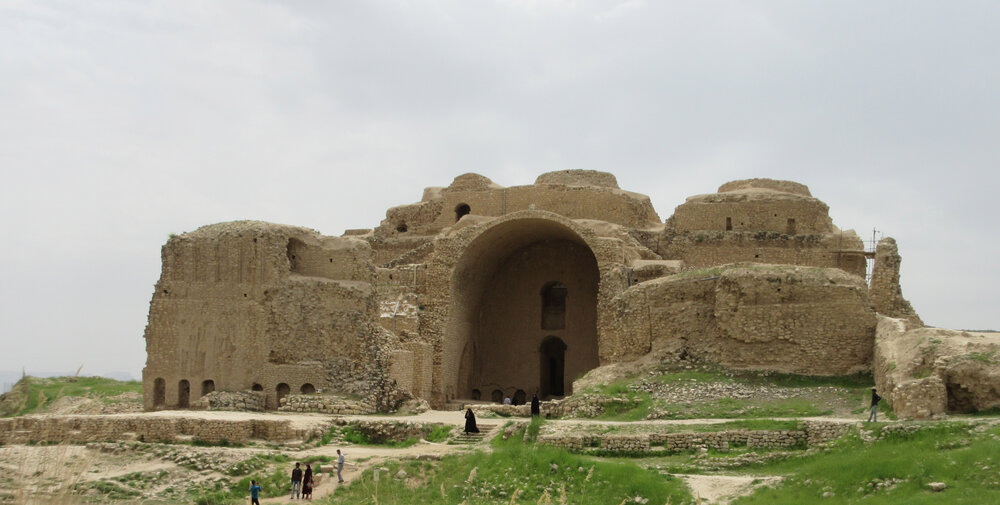Visit Firuzabad, once politico-cultural capital of Sassanids

TEHRAN - Firuzabad, formerly known as Gur, was once a politico-cultural capital of the Sassanid Empire (224–651).
Firuzabad was established by one of the Sassanid kings, Ardeshir Babakan. The city was significant at the time because it was one of the Sassanid Empire’s strategic cities.
An approximate 3579 km2 is the size of Firuzabad, which is situated south of Shiraz. Sassanid art and architecture enthusiasts flock to Firuzabad every year because the city is home to numerous relics from the era. It is a popular Iranian tourist destination.
It was a key region for the government in the Achaemenid Empire. But Firuzabad found a special place in the area and rose to become the capital during the rule of Ardashir Babakan.
Palace of Ardeshir Babakan
The Palace of Ardeshir Babakan is unique among Iranian structures because it is situated on a square-shaped platform.
Most historical Iranian monuments have a circular base to their architecture. Meanwhile, the use of a square model in the construction of palaces became popular among Iranian architects in the Sassanid era.
The palace that once belonged to Ardeshir Babakan is one of the most impressive features of ancient Firuzabad, which still exudes a sense of the Sassanid era. It served as his government’s central office.
There are many corridors and iwans (porticos) throughout the structure that has 116 meters long and 55 meters wide. There are halls connected by iwans in both the eastern and western portions of this palace. The palace’s triple domes are among its most notable features.
Ardeshir Palace is one of the most notable examples of Sassanid-era architecture, embellished with lovely stuccos and sturdy vaults. The distinction between the palace’s official and residential areas is another intriguing aspect. As a result, there is a large hall adjacent to the administrative palace that was built to host meetings between the king and officials from the government.
The main courtyard and a lake are creating a beautiful view of the palace of Ardeshir at the end of the palace and its exterior. However, the lake is also visible from the palace’s exterior.
Qal’eh Dokhtar
Qal’eh Dokhtar, which literally means the Maiden Castle, is another historical representation of Sassanid art and architecture.
In terms of Sassanid architecture, this castle, perched above the local peaks, is very significant.
This palace is one of a kind and has an amazing layout, with a hierarchical floor plan and numerous staircases and corridors.
This castle is an example of Sassanid architecture and is constructed from rock and plaster mortar with a specific dome.
It was believed that a subterranean hall connected Qal’eh Dokhtar, which Ardeshir Babakan considered safe and impenetrable due to its impassability, to the palace of Ardeshir.
Minaret of Gur
The tower-like Minaret of Gur is a one-of-a-kind building of its time. The building’s base is square under Sassanid architectural form, and the remainder has been transformed into a tower.
The Minaret of Gur was one of the official symbols of the area during the Sassanid era and a representation of imperial power. It was situated in the middle of the historic city of Firuzabad.
About nine meters long and 30 meters high, this structure is made of granite and mortar. Archaeologists and historians claim that, in addition to serving as a symbol, this building also served as a temple, a water storage facility, and other practical purposes.
Rock Relief of Ardeshir’s victory
One of the main reliefs of the Firuzabad Ensemble, dating back to the Sassanid Empire, is called Naqsh-e Piroozi, or the Rock Relief of Ardeshir’s victory.
It portrays Ardeshir Babakan’s victory over Ardavan V in battle using all the characteristics of Sassanid rock carvings.
This relief also makes clear the actual condition of the figures, their angles, and the level of detail that was paid to them. The Ardeshir’s victory rock relief was carved from three different angles and is one of the non-religious carvings.
AFM
Leave a Comment